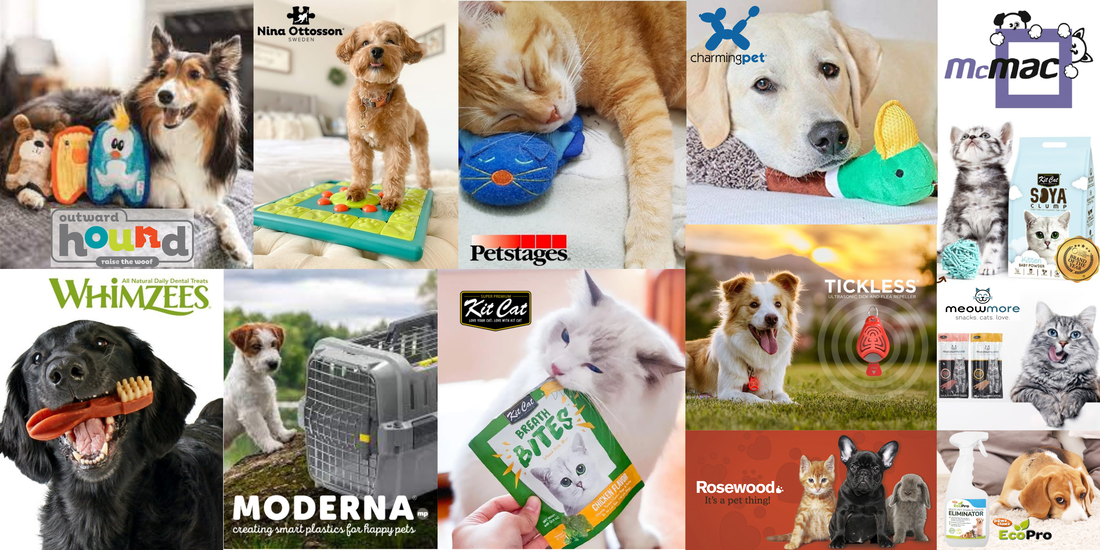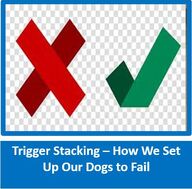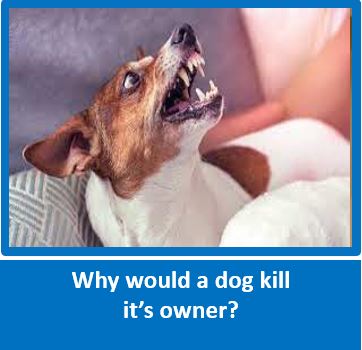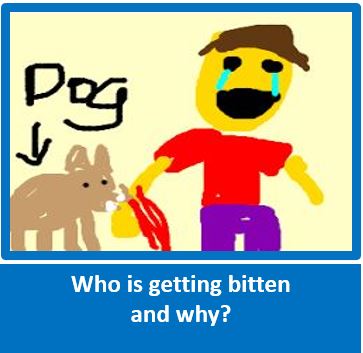What does one do when your dog starts growling at you?!
Courtesy of Dr. M. Greenberg (Accredited Animal Behaviour Consultant (ABC of SA™)
Courtesy of Dr. M. Greenberg (Accredited Animal Behaviour Consultant (ABC of SA™)
.

Growling is a valuable and natural means of communication for any dog – something that dog owners should appreciate and respect rather than punish. It is quite obvious that none of us feel comfortable, safe or accepting of this behaviour. None of us want our dog to growl at us but neither do we want him to fail to growl if something makes him uncomfortable; that is very important information in a successful human-canine relationship. It is also imperative that, as a dog owner, you understand the various growls that dogs emit to other dogs and to humans. It can be for soliciting play, an expression of fear, territoriality, protectiveness, food-related, possessiveness, dominance posturing or a warning of aggression.
It is very common for pet owners to punish their dogs for growling. Unfortunately aggression breeds further aggression or may suppress the growl thus eliminating his ability to warn us that he is about to snap, literally and figuratively – the dog may never growl when intruders are detected.
If you are not supposed to shout or hit your dog when it growls it is vitally important to know what to do. Every dog owner should have an educated action plan in the event that this threatening vocalization does not intimidate you into fear response but rather into an action plan to ensure the safety of all concerned.
Very often a growl is a warning – be grateful. If the dog’s bite immediately follows the growl then you may be dealing with a more serious situation. Some growls may change in pitch and volume in response to the amount of attention the pup or dog receives by its actions. A play growl can be distinguished from a serious one. The former is usually high-pitched, short and frequently repeated while the latter is low-pitched, prolonged and sometimes no change in tone. Pet owners should learn to discriminate.
Next time your dog growls at you stop whatever you are doing. Do not push the animal over the growl threshold. Be safe rather than sorry. If the growl does not mean a bite is imminent, stop what you are doing but stay exactly where you are. Wait until the dog relaxes then move away so you are rewarding the relaxed behaviour rather than the growl.
In every instance one must carefully and seriously analyse the situation that elicited the growl. Was the dog being touched or groomed? Was it being restrained in a rough manner it does not understand or accept? Were people making eye contact and making the dog feel ill-at-ease? Was something precious taken away from him? Were people making him do something strange? All these questions, plus more, should be asked, identified and dealt with before the interaction escalates to a dangerous level. Very often, children left alone with a puppy can elicit growling followed by aggression. Anecdotally, in animal behaviour practice, I have seen this in clear-cut cases where a child has picked up a pup, carried it around like a toy and dropped it for “fun”; where a brat has put fine stone granules down a pup’s ear canal; where a group of kids had tied an elastic band around the dog’s muzzle until it cut through the skin, got covered by its own wound and was noticed months later due to the odour coming from the dog. Who would not growl when these children approached? Believe it or not, dogs feel pain and have a brilliant memory of association!
Most pups and dogs will relay their fear in this manner of self-preservation. In the vast majority of circumstance the humans are to blame for behaving inappropriately during puppy-hood e.g. badgering the pup’s face until it growls, in self-defence, then it receives a hand crack over its muzzle for being “cheeky”. Animal behaviourists are mesmerized by the stupid behaviour of dog owners and the question often posed is whether the owner would like to be on the receiving end of being hectored and be obediently tolerant?!
The next step in the growling dog is to figure out a way to accomplish your aim of interaction without eliciting a growl. Lure the dog rather than physically forcing, pushing or pulling. The most successful way in which to win over any dog is ensure that you are the only one that feeds it, that you offer set meals so that the dog attaches a value to you then your significance escalates exponentially by offering an unpredictable delayed feeding programme. The latter is a wonderful counter-conditioning concept with serious aggression. The dog has no idea when the next meal is expected. The intervals between meals can be extended enough to make it hanker a bit for food. As an example, feeding dinner then no meal for two days (water always available) followed by a breakfast then no meal for two days followed by a lunch has cured some of the most vicious dogs that have mauled their owners – where the victims have refused euthanasia of their pet. Once the dog’s behaviour improves the intervals are shortened between meals but always remains unpredictable. Controlling a dog’s food is equated to controlling a worker’s salary – it induces enormous respect very quickly.
Feed the dog treats while you touch, groom or restrain. If you do not have to do whatever elicited the growl, don’t! – until you can convince the pet dog that it is a good thing rather than a bad experience. This has to be considered within the realms of reasonable expectation. A trustworthy dog must allow you to do anything within reason with total acceptance but you cannot expect it do tolerate a stress factor that you would never allow.
Dogs need to face the realities of life provided it is within the gambit of responsible pet ownership – the dog cannot dictate to you otherwise you will be in serious trouble.
Evaluate the stressors in your dog’s world the try to reduce or eliminate as many of them as possible e.g.antagonizing the dog with the use of a vacuum cleaner – place the dog outside, far away from the house-cleaning, so that the job gets done and the dog is not stressed. Fence-running and fence-fighting can be eliminated by cordoning off the property so that the dog is not at the threshold of the gate or the perimeter fence. Sound sensitive dogs should be under strict veterinary medication for the phobia. The list of possible stress factors may be vast.
Keep in mind that stress causes aggression and stressors are cumulative. It is not just the immediate stimulus that caused the growl but a combination of all the contributing factors the dog experienced in the days leading up to it e.g. a thunderstorm, a family argument and a visit by strangers may explain why there is an ultimate surprising growl – a syndrome, yet an accumulation of anxious moments very often experienced by the dog in the presence of its owners.
It is important to institute an aggressive behaviour modification programme with the guidance and experience of an accredited animal behaviourist. One has to use positive dog-friendly techniques. The idea is to change the dog’s opinion about the stimulus that made it growl. Part of the therapy is to counter-condition and desensitize the dog by convincing it that the bad thing is, in fact, a positive asset. Instead of using the vacuum cleaner and creating noise, place it within a reasonable distance of the dog’s food bowl so that it develops an association that this “beacon” is an indicator of a scrumptious meal – and it is welcome to hang around. By successive approximation the appliance can be placed closer and closer over a period of weeks. When fully tolerated at close quarters it can then be set up furthest away but in full view and switched on only for a second or two. This can be increased until the dog tolerates its immobility and sound in the distance – so it goes on….
The entire content of this topic can be prevented by subscribing to puppy socialization classes from 8 weeks of age. Besides teaching the young pup social skills, tolerance and obedience, the owners is taught how to behave with an impressionable and what steps to take in the vent of a problem. Prevention is better and easier than trying to cure! Any dog growling at a human must be construed as abnormal – if unprovoked.
A small minority of dogs e.g. a certain strain in Rottweilers are, by nature, growling communicators where their growl is bigger than their bite – the bottom line is that you have to know that!
It is very common for pet owners to punish their dogs for growling. Unfortunately aggression breeds further aggression or may suppress the growl thus eliminating his ability to warn us that he is about to snap, literally and figuratively – the dog may never growl when intruders are detected.
If you are not supposed to shout or hit your dog when it growls it is vitally important to know what to do. Every dog owner should have an educated action plan in the event that this threatening vocalization does not intimidate you into fear response but rather into an action plan to ensure the safety of all concerned.
Very often a growl is a warning – be grateful. If the dog’s bite immediately follows the growl then you may be dealing with a more serious situation. Some growls may change in pitch and volume in response to the amount of attention the pup or dog receives by its actions. A play growl can be distinguished from a serious one. The former is usually high-pitched, short and frequently repeated while the latter is low-pitched, prolonged and sometimes no change in tone. Pet owners should learn to discriminate.
Next time your dog growls at you stop whatever you are doing. Do not push the animal over the growl threshold. Be safe rather than sorry. If the growl does not mean a bite is imminent, stop what you are doing but stay exactly where you are. Wait until the dog relaxes then move away so you are rewarding the relaxed behaviour rather than the growl.
In every instance one must carefully and seriously analyse the situation that elicited the growl. Was the dog being touched or groomed? Was it being restrained in a rough manner it does not understand or accept? Were people making eye contact and making the dog feel ill-at-ease? Was something precious taken away from him? Were people making him do something strange? All these questions, plus more, should be asked, identified and dealt with before the interaction escalates to a dangerous level. Very often, children left alone with a puppy can elicit growling followed by aggression. Anecdotally, in animal behaviour practice, I have seen this in clear-cut cases where a child has picked up a pup, carried it around like a toy and dropped it for “fun”; where a brat has put fine stone granules down a pup’s ear canal; where a group of kids had tied an elastic band around the dog’s muzzle until it cut through the skin, got covered by its own wound and was noticed months later due to the odour coming from the dog. Who would not growl when these children approached? Believe it or not, dogs feel pain and have a brilliant memory of association!
Most pups and dogs will relay their fear in this manner of self-preservation. In the vast majority of circumstance the humans are to blame for behaving inappropriately during puppy-hood e.g. badgering the pup’s face until it growls, in self-defence, then it receives a hand crack over its muzzle for being “cheeky”. Animal behaviourists are mesmerized by the stupid behaviour of dog owners and the question often posed is whether the owner would like to be on the receiving end of being hectored and be obediently tolerant?!
The next step in the growling dog is to figure out a way to accomplish your aim of interaction without eliciting a growl. Lure the dog rather than physically forcing, pushing or pulling. The most successful way in which to win over any dog is ensure that you are the only one that feeds it, that you offer set meals so that the dog attaches a value to you then your significance escalates exponentially by offering an unpredictable delayed feeding programme. The latter is a wonderful counter-conditioning concept with serious aggression. The dog has no idea when the next meal is expected. The intervals between meals can be extended enough to make it hanker a bit for food. As an example, feeding dinner then no meal for two days (water always available) followed by a breakfast then no meal for two days followed by a lunch has cured some of the most vicious dogs that have mauled their owners – where the victims have refused euthanasia of their pet. Once the dog’s behaviour improves the intervals are shortened between meals but always remains unpredictable. Controlling a dog’s food is equated to controlling a worker’s salary – it induces enormous respect very quickly.
Feed the dog treats while you touch, groom or restrain. If you do not have to do whatever elicited the growl, don’t! – until you can convince the pet dog that it is a good thing rather than a bad experience. This has to be considered within the realms of reasonable expectation. A trustworthy dog must allow you to do anything within reason with total acceptance but you cannot expect it do tolerate a stress factor that you would never allow.
Dogs need to face the realities of life provided it is within the gambit of responsible pet ownership – the dog cannot dictate to you otherwise you will be in serious trouble.
Evaluate the stressors in your dog’s world the try to reduce or eliminate as many of them as possible e.g.antagonizing the dog with the use of a vacuum cleaner – place the dog outside, far away from the house-cleaning, so that the job gets done and the dog is not stressed. Fence-running and fence-fighting can be eliminated by cordoning off the property so that the dog is not at the threshold of the gate or the perimeter fence. Sound sensitive dogs should be under strict veterinary medication for the phobia. The list of possible stress factors may be vast.
Keep in mind that stress causes aggression and stressors are cumulative. It is not just the immediate stimulus that caused the growl but a combination of all the contributing factors the dog experienced in the days leading up to it e.g. a thunderstorm, a family argument and a visit by strangers may explain why there is an ultimate surprising growl – a syndrome, yet an accumulation of anxious moments very often experienced by the dog in the presence of its owners.
It is important to institute an aggressive behaviour modification programme with the guidance and experience of an accredited animal behaviourist. One has to use positive dog-friendly techniques. The idea is to change the dog’s opinion about the stimulus that made it growl. Part of the therapy is to counter-condition and desensitize the dog by convincing it that the bad thing is, in fact, a positive asset. Instead of using the vacuum cleaner and creating noise, place it within a reasonable distance of the dog’s food bowl so that it develops an association that this “beacon” is an indicator of a scrumptious meal – and it is welcome to hang around. By successive approximation the appliance can be placed closer and closer over a period of weeks. When fully tolerated at close quarters it can then be set up furthest away but in full view and switched on only for a second or two. This can be increased until the dog tolerates its immobility and sound in the distance – so it goes on….
The entire content of this topic can be prevented by subscribing to puppy socialization classes from 8 weeks of age. Besides teaching the young pup social skills, tolerance and obedience, the owners is taught how to behave with an impressionable and what steps to take in the vent of a problem. Prevention is better and easier than trying to cure! Any dog growling at a human must be construed as abnormal – if unprovoked.
A small minority of dogs e.g. a certain strain in Rottweilers are, by nature, growling communicators where their growl is bigger than their bite – the bottom line is that you have to know that!





